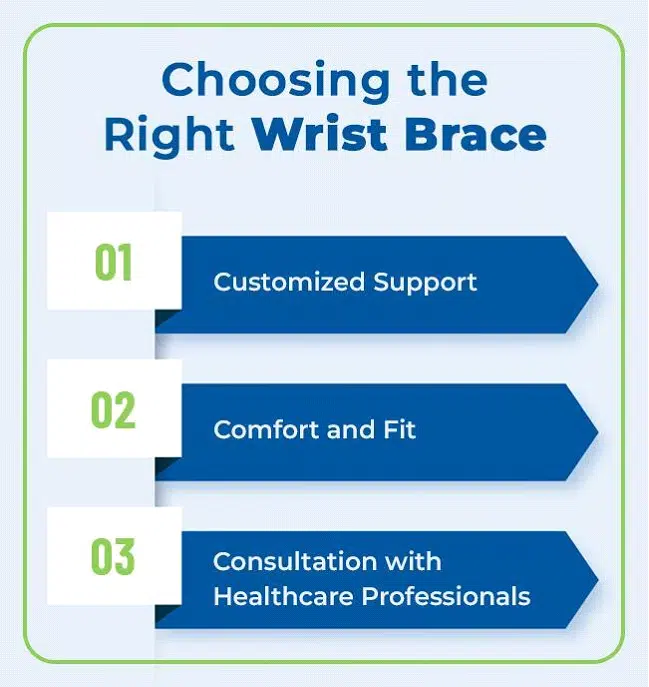Our wrists play a crucial role in our daily lives, facilitating a wide range of activities, from typing on a keyboard to lifting objects. However, wrist injuries or conditions such as sprains, strains, and carpal tunnel syndrome can limit mobility and cause discomfort. Fortunately, wrist braces have emerged as a game-changer, revolutionizing wrist support and empowering individuals to embrace every moment confidently and comfortably.
Understanding the Importance of Wrist Braces
The wrist is one of the body parts that often get hurt since it’s made up of several tiny bones, ligaments, and small muscles that can easily become stressed. This can happen as a result of something simple such as overuse or repetitive movements while working, doing sports, or a hobby. Wrists also take some abuse if you use your hands to break a fall.
Wrist braces are specialized devices designed to support, stabilize, and compress the wrist joint. These braces are commonly used for various purposes, including injury prevention, rehabilitation after wrist injuries or surgeries, and managing chronic conditions such as carpal tunnel syndrome. Wrist braces are available in different designs, including splint-based braces and elastic wraps, offering customizable support based on individual needs.
Injury Prevention and Protection
1. Sports and Physical Activities
Engaging in sports and physical activities can strain the wrists, increasing the risk of sprains, strains, or even fractures. Wrist braces offer proactive protection by providing stability and limiting excessive movements, reducing the likelihood of injuries. Athletes, fitness enthusiasts, and individuals participating in activities such as weightlifting, tennis, basketball, or gymnastics can benefit from the added support and protection provided by wrist braces.
2. Occupational Hazards
Certain occupations, such as those involving repetitive wrist movements or heavy lifting, pose a higher risk of wrist injuries. Wrist braces offer a preventive solution by providing support and minimizing the strain on the wrist joint during work-related activities. Individuals in professions such as construction, manufacturing, office work, or healthcare can benefit from wearing wrist braces to reduce the risk of work-related wrist injuries.
Rehabilitation and Post-Injury Support
1. Wrist Sprains and Strains
Wrist braces play a crucial role in the rehabilitation process after wrist sprains or strains. These braces provide stability, restrict movements that may aggravate the injury, and allow for proper healing. By immobilizing the wrist and reducing stress on the injured area, wrist braces promote recovery, alleviate pain, and facilitate the restoration of normal wrist function.
2. Post-Surgery Rehabilitation
After wrist surgery, such as wrist fracture repair or carpal tunnel release, wearing a wrist brace is often recommended during rehabilitation. The brace helps protect the surgical site, support the healing process, and provide stability as the wrist recovers. Wrist braces contribute to the successful rehabilitation of the wrist joint, allowing individuals to regain strength and range of motion.
Managing Chronic Conditions
1. Carpal Tunnel Syndrome
Carpal tunnel syndrome is a common condition characterized by compression of the median nerve in the wrist, leading to pain, numbness, and weakness in the hand. Wrist braces are an integral part of non-surgical management for carpal tunnel syndrome. By keeping the wrist in a neutral position and providing gentle compression, wrist braces alleviate symptoms, reduce pressure on the median nerve, and promote overall wrist comfort.
2. Arthritis and Joint Support
Individuals with arthritis or other joint conditions affecting the wrist can benefit from the support and stabilization provided by wrist braces. These braces help reduce pain, inflammation, and discomfort associated with wrist arthritis. By providing compression and limiting excessive movements, wrist braces contribute to improved joint stability and enhanced function.
Enabling an Active Lifestyle
1. Confidence in Physical Activities
Wrist braces instill confidence in individuals to engage in physical activities and sports, knowing that their wrists are adequately supported and protected. Whether participating in weightlifting, yoga, Pilates, or other recreational activities, wrist braces allow individuals to push their limits and embrace an active lifestyle with reduced fear of wrist injuries.
2. Daily Tasks and Work
Wrist braces support individuals in performing daily tasks and activities requiring repetitive wrist movements, such as typing, writing, cooking, or manual labor. By providing stability and reducing strain on the wrists, these braces minimize discomfort and fatigue, enabling individuals to carry out their responsibilities with greater ease and productivity.
Read More: Wrist Braces: Protect and Heal Your Wrists
Choosing the Right Wrist Brace
1. Customized Support
When selecting a wrist brace, it’s crucial to consider individual needs and the specific condition or purpose for which the brace will be used. Different types of braces offer varying levels of support and features. Some braces have adjustable straps or splints that can be customized for optimal comfort and support.
2. Comfort and Fit
A well-fitted wrist brace is essential for comfort and effectiveness. It should provide a snug fit without restricting circulation or causing discomfort. High-quality materials and breathable designs contribute to long-term wearability, ensuring comfort throughout daily activities.
3. Consultation with Healthcare Professionals
Individuals with specific wrist conditions or post-injury requirements should consult with healthcare professionals, such as orthopedic specialists or physical therapists, to determine the most suitable wrist brace. These professionals can provide personalized recommendations based on the individual’s unique needs and assist in proper fitting and usage.
Incorporating Wrist Braces into Daily Life
1. Proper Usage and Duration
It’s important to follow the instructions provided by healthcare professionals or the manufacturer regarding the usage and duration of wearing the wrist brace. Adhering to recommended guidelines ensures optimal support and aids in the healing process.
2. Balancing Rest and Rehabilitation
While wrist braces provide support, it’s crucial to balance wearing the brace and allowing the wrist to rest and rehabilitate. This balance ensures the necessary healing and recovery while maintaining wrist mobility and strength.
Embracing Every Moment with Confidence
Wrist braces are not just supportive devices; they empower individuals to embrace every moment confidently. By providing stability, protection, and comfort, wrist braces enable individuals to engage in daily activities, pursue hobbies, and lead an active lifestyle without the limitations and fear of wrist injuries.
Conclusion
Our wrists play a crucial role in our daily lives, facilitating a wide range of activities, from typing on a keyboard to lifting objects. However, wrist injuries or conditions such as sprains, strains, and carpal tunnel syndrome can limit mobility and cause discomfort. Fortunately, wrist braces have emerged as a game-changer, revolutionizing wrist support and empowering individuals to embrace every moment confidently and comfortably.
If you’re unsure what product is right for you or if you’re eligible for insurance coverage, Artik Medical Supply will provide the guidance you need. Their wrist braces come in several sizes and provide lightweight and breathable support so that you can comfortably continue your daily routine. They can even communicate with your doctor to determine the best wrist product for you. Contact them today for a free eligibility check.








